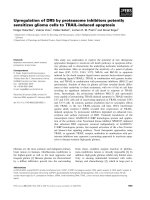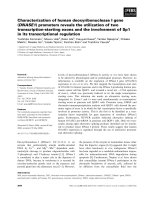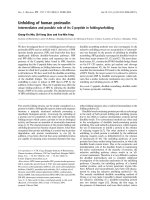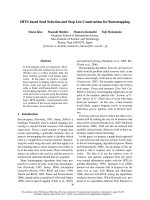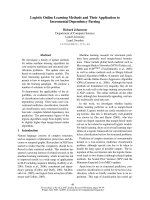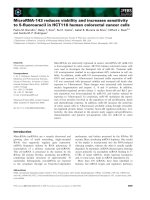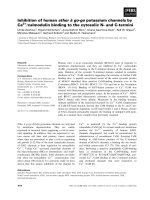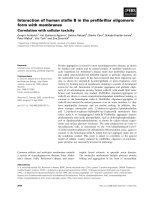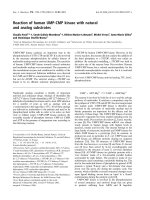Báo cáo khoa học: Platination of telomeric sequences and nuclease hypersensitive elements of human c-myc and PDGF-A promoters and their ability to form G-quadruplexes Viktor Viglasky potx
Bạn đang xem bản rút gọn của tài liệu. Xem và tải ngay bản đầy đủ của tài liệu tại đây (344.17 KB, 9 trang )
Platination of telomeric sequences and nuclease
hypersensitive elements of human c-myc and PDGF-A
promoters and their ability to form G-quadruplexes
Viktor Viglasky
Department of Biochemistry, Faculty of Sciences, Institute of Chemistry, P. J. Safarik University, Kosice, Slovakia
G-rich regions appear in several locations in the
human genome, including at the ends of linear chrom-
omes, the immunoglobin switch region, centromeres,
fragile X syndrome repeats, and promoters of some
genes [1]. The sequences repeated in tandem, with three
or four adjacent guanines, have been known to form
polymorphic quadruplexes containing G-quartets stabi-
lized by cyclic Hoogsteen hydrogen bondings. Quadru-
plex structures are highly stable DNA or RNA
structures formed on G-rich sequences [2]. The Na
+
and K
+
ions stabilize the stacking through their inter-
actions with carbonyl oxygens of the eight guanines of
two adjacent quartets [3]. Direct evidence for the pres-
ence of G-quadruplex structures in vivo has been
reported both at the telomeres of the ciliate Stylonychi-
a [4] and those of humans [5], and at the promoter of
c-myc [6,7]. Moreover, other genomic regions were
shown to be able to adopt quadruplex structures, such
as the promoters of c-kit oncogene [6], HIF-1a [9],
Bcl2 [10] and vascular endothelial growth factor [11].
The stabilization of the G-quadruplex structure by
small molecules is currently emerging as a very promis-
ing anti-cancer strategy. Therefore, molecules that stabi-
lize G-quadruplex structures can be used as potential
anti-cancer agents [12]. Indeed, recent studies strongly
suggest that molecules able to stabilize the quadruplex
structure of DNA can lead to an arrest of the prolifera-
tion of cancer cells [5,12–14]. At each division of
somatic cells, telomeres are shortened, a process leading
to senescence and death. It has been shown in vitro that
G-quadruplex structures of the human sequence
(G
3
T
2
A)
3
G
3
formed in the presence of molecules stabi-
lizing the G-quartet stacks, similar to anthraquinones or
porphyrins, inhibit the activity of telomerase [13–17].
The anti-tumor drug cisplatin (cis-[PtCl2(NH3)2]),
known for its high affinity for G-rich sequences, was
Keywords
cisplatin; c-myc; G-quadruplex; PDGF-A
promoter; telomeric sequences
Correspondence
V. Viglasky, Department of Biochemistry,
Faculty of Sciences, Institute of Chemistry,
Safarik University, Moyzesova 11, 04011
Kosice, Slovakia
Fax: +421 55 622 21 24
Tel: +421 55 234 12 62
E-mail:
(Received 30 August 2008, revised 5
November 2008, accepted 7 November
2008)
doi:10.1111/j.1742-4658.2008.06782.x
Naturally occurring G-rich DNA sequences that are able to form G-quad-
ruplex structures appear as potential targets for anti-cancer chemotherapy,
and therefore play an important role in cellular processes, such as cell
aging, death and carcinogenesis. The telomeric regions of DNA and nucle-
ase hypersensitive elements of human c-myc and PDGF-A promoters repre-
sent a very appealing target for cisplatin and may interfere with normal
DNA function. Platinum complexes bind covalently to nucleobases, and
especially to the N7 atom of guanines, and the four guanines of a G-quar-
tet have their N7 atoms involved in hydrogen bonding. Therefore, within a
G-quadruplex structure, only the guanines out of the stack of G-quartets
should react with electrophilic species such as platinum (II) complexes.
Platinum complexes have significant influence on the formation of G-quad-
ruplexes. Results obtained by CD spectroscopy and temperature gradient-
gel electrophoresis clearly demonstrate that DNA platination significantly
affects G-quadruplex folding for telomeric sequences; the abundance of
un ⁄ misfolded DNAs compared to the G-quadruplex is proportional to the
platinum concentration.
Abbreviation
TGGE, temperature gradient-gel electrophoresis.
FEBS Journal 276 (2009) 401–409 ª 2008 The Author Journal compilation ª 2008 FEBS 401
found to inhibit telomerase activity in testicular cancer
cells [18] and to reduce telomere length in treated cells
[19]. The anti-tumor drug cisplatin forms two kinds of
cross-links with DNA: intrastrand and interstrand.
Platinum complexes react with cellular DNA, primarily
binding to the N7 positions of guanine bases, forming
60–65% chelates between adjacent guanines named the
1,2-GG adducts, 20% of 1,2-AG adducts and a small
amount of interstrand cross-links [20]. It is unclear
how cisplatin induces cytotoxicity but it is widely
attributed to the formation of the major 1,2-GG
adduct because the tumor response correlates with the
levels of 1,2-GG adducts [21]. The formation of inter-
strand crosslinks requires partial disruption of the
Watson–Crick base pairing within double strand
DNA, and the cross-linking reaction could therefore
be expected to be rather slow. However, by contrast,
kinetic measurements indicate that interstrand cross-
linking is as fast as intrastrand cross-linking, or even
faster [22]. However, the four guanines of a G-quartet
have their N7 atoms involved in hydrogen bonding.
Therefore, within a G-quadruplex structure, only the
guanines outside the stack of G-quartets should react
with electrophilic species such as platinum complexes.
The influence of platination on the telomeric sequences
was described previously by Garnier et al. [22], but the
effect of platination on the quadruplex formation has
never been described in detail. Guanine-guanine cross-
linking by platinum atoms either welds together
contiguous guanine residues and stabilizes the G-qua-
druplex or the occupancy of N7 hydrogen bonds desta-
bilizes these structural motifs. The suggestion that
platinum complexes significantly affect the structure of
G-quadruplexes is shown.
Various G-rich sequences prone to form quadruplex
motifs are investigated in the present study. Tempera-
ture gradient-gel electrophoresis (TGGE) has been
applied for the first time to study quadruplex confor-
mational stability. The results obtained by CD spec-
troscopy and TGGE clearly demonstrate that the
telomeric G-quadruplexes are very sensitive to covalent
platinum modification by platinum, but not nuclease
hypersensitive elements of human c-myc and PDGF-A
promoters; the abundance of unfolded DNA is propor-
tional to the platinum concentration.
Results
CD spectrum of G-rich oligonucleotides
CD spectra have been extensively applied to the study
of G-quadruplex structures. It is well known that par-
allel G-quadruplex structures, such as propeller forms,
give a positive band at approximately 263 nm and a
negative band at approximately 240 nm, whereas anti-
parallel G4 structures, such as basket and chair forms,
show two positive bands at approximately 295 and
240 nm and a negative band at approximately 260 nm.
These spectral features are mainly attributed to the
specific guanine stacking in various G4 structures.
Figure 1 shows the CD spectra of c-MYC, PDGF-A,
Tel-1 and Tel-2 oligonucleotides in 50 mm Tris–HCl
containing 50 mm K
+
cations. According to the find-
ing of multiple conformations, the 293 nm positive CD
band associated with a 265 nm positive shoulder of
Tel-1 is probably due to the co-existence of both paral-
lel and antiparallel G4 structures in K
+
solution
[3,23]. The CD pattern of Tel-1 is similar to the CD
pattern of d(TAGGGTTAGGGT) and NMR analysis
has revealed the co-existence of the dimeric antiparallel
and parallel G4 structures in K
+
solution [23,24]. The
CD spectra of different oligonucleotides show that
c-MYC and PDGF-A sequences preferentially form
the parallel G-quadruplex structure in 50 mm Tris-HCl
buffer at pH 7.8, and the maximum of ellipticity is
observed at 263 nm. These results agree with the mea-
surements obtained in previous studies [14]. However,
telomeric sequences Tel-1 and Tel-2 form a preferen-
tially antiparallel configuration of G-quadruplex struc-
ture in solutions containing the K
+
ion, with the
maximum being observed at 293 nm. The increase of
K
+
facilitates the folding of G-quadruplexes, and the
peak at 293 nm increases [25]. Interestingly, when a
Fig. 1. Comparative CD spectra of four known G-quadruplex-
forming sequences: Tel-1 (open circle), Tel-2 (solid circle), c-MYC
(diamond) and PDGF-A (triangle) in 50 m
M Tris–HCl buffer (pH 7.8)
with 50 m
M KCl. Each spectrum corresponds to three averaged
scans taken at 20 °C and is baseline corrected for signal contribu-
tion due to the buffer.
Influence of platinum complexes on G-quadruplexes V. Viglasky
402 FEBS Journal 276 (2009) 401–409 ª 2008 The Author Journal compilation ª 2008 FEBS
DNA tract of repetition contains more than three
residues of guanines, then a small amount of DNA
without the presence of K
+
is folded into the G-quad-
ruplex structure at room temperature. Defrosted stock
solution of G-rich oligomer in distilled water contains
a nonzero amount of folded G-quadruplex structure,
which is detectable by CD spectroscopy; this was
observed for Tel-2, c-MYC and PDGF-A [26]. This is
most likely due to the residual amount of monovalent
ions that was not removed during desalting process,
but is still sufficient for stabilization of the G-quadru-
plex motif.
CD spectra of platinated Tel-1 and Tel-2
Platination of oligonucleotides was performed in dis-
tilled water in the presence of 10 mm KClO
4
, where
the G-quadruplex should form a stable conformation.
In the case where the platination is performed in dis-
tilled water without any univalent ions, a very low
amount of folded G-quadruplex is detected by CD
spectroscopy (data not shown). Figure 2 shows the
influence of platination on the G-quadruplex destabili-
zation for Tel-2. Increasing the number of cisplatin
molecules per oligonucleotide rapidly decreases the
positive and negative elliptic peaks of Tel-2 at 293, 242
and 262 nm, respectively. The same effects were
observed for five additional oligonucleotides:
d(G
3
T
3
)
3
G
3
, d(G
4
T
3
)
3
G
4
, d(G
4
T
2
)
3
G
4
, d(G
4
T
2
)
3
G
4
and
d(G
4
T
2
A)
3
G
4
(data not shown). The intersected isosbe-
stic points were detected nearby, at 237, 252 and
280 nm at the given conditions for Tel-2. An addi-
tional increase of the K
+
concentration in solution
during the collection of CD spectra has no significant
effect on the ellipticity of Tel-2. These multi-isosbestic-
point spectra are clear evidence for the formation of
intermediates [27]. A molar ratio of 1 : 1 platinum
complexes incubated with DNA oligomer decreases the
ellipticity at 293 nm by approximately 20%. An
increase in the amount of platinum complexes incu-
bated with DNA oligonucleotide (four platinum com-
plexes per oligomer) causes an additional decrease of
this characteristic peak, by approximately 38%. A
molar ratio of 16 platinum complexes to oligomer can
occupy all guanines of Tel-2 oligonucleotide; this
decreases the ellipticity by approximately 73% com-
pared to the original nonplatinated oligonucleotides
under the same conditions. A similar effect had also
been observed for trans-platinum complex (data not
shown). Interestingly, single platinum molecules per
parallel c-MYC and PDGF-A do not show the effect
of a decreasing peak at 263 nm, probably due to the
preference of cisplatin to bind with guanines occurring
in the loop of the G-quadruplex motif, and these N7
nitrogens of guanine are not associated with Hoogs-
teen pairing of the G-tetrad. When the amount of
platinum complexes achieves a molar ratio of four
molecules per oligonucleotide, then the same effect is
observed as for Tel-1 and Tel-2; the decrease of ampli-
tude of the characteristic peaks for parallel structures
is observed (263 and 240 nm). The decrease of peaks
should correlate with the amount of oligomers
correctly folded into the quadruplex structure.
Analysis of thermal stability of G-quadruplexes
The results shown in Fig. 3 clearly demonstrate that
the number of G-tetrad in quadruplex is the
determining factor for the thermal stability of both
parallel and antiparallel G-quadruplexes. Thermal
stability in the presence of KCl is: Tel-1 <
Tel-2 < c-MYC < PDGF-A quadruplexes (Table 1).
The results again confirm that the concentration of
K
+
is a determining factor for the thermal stability
of G-quadruplexes. The data shown in Fig. 3A,B,D
are normalized.
TGGE analysis – influence of platination on
thermal stabilization
The original data shown in Fig. 3C confirm that
platination decreases the amount of correctly folded
Fig. 2. Representative CD spectra of Tel-2 in 50 mM Tris–HCl
buffer (pH 7.8) with 50 m
M KCl. Various amounts of platinum
complexes incubated with DNA were used. The molar ratios of
platinum complexes incubated per oligomer were: 0 : 1, 1 : 1, 4 : 1
and 16 : 1. All spectra were collected at 20 °C and in a strand
concentration of 15 l
M.
V. Viglasky Influence of platinum complexes on G-quadruplexes
FEBS Journal 276 (2009) 401–409 ª 2008 The Author Journal compilation ª 2008 FEBS 403
oligomers into the antiparallel G-quadruplex. Platina-
tion does not principally affect the melting tempera-
tures of Tel-1 and Tel-2; the normalized data shown in
Fig. 3D and Table 1 confirm this claim. However, the
transition is widespread for platinated oligonucleotides.
An explanation of why the covalent modification of
oligonucleotides does not affect thermal stability is
offered by the TGGE results (Fig. 4).
In Fig. 4, the thermal mobility profiles of platinated
and nonplatinated Tel-1 are compared. Tel-1 mobility
shows a sigmoidal profile, as expected based on CD
measurements, but platination causes an increasing
amount of unfolded conformational states (Fig. 4,
area highlighted by double arrow). Folded and
unfolded conformations are depicted by solid and
empty arrows, respectively. The double arrow high-
lights the ‘smear area’ representing a population of
unfolded and misfolded oligonucleotides. The intensity
of this area is increased by the increasing ratio of
cisplatin to DNA.
Ridge tracking analysis, as applied for proteins, was
used for this purpose. T
m
values were the same
(55 ± 2 °C) for both TGGE and CD measurements.
The TGGE results clearly demonstrate that CD spec-
troscopy results are a convolution of the misfolded
and folded spectra of the G-quadruplexes. An identical
melting profile of the original (Fig. 4, top) and the pla-
tinated DNA (Fig. 4, bottom) is observed after exclud-
ing the smear from the electrophoretic record
representing any intermediates (Fig. 4). The increased
ratio between cisplatin and the oligomer causes an
increased abundance of the misfolded population of
G-quadruplexes.
Discussion
The present study aimed to evaluate whether cisplatin
is able covalently to trap quadruplex structures. TGGE
and CD spectroscopy were used to characterize the
folding of platinated G-quadruplex sequences.
This structural motif usually plays an important
biological role. In particular, the folding of telomeric
DNA into the G-quadruplex has been shown to inhi-
bit telomerase, an enzyme involved in the maintenance
of the telomere length in cancerous cells [2,14]. The
human quadruplexes of telomeric sequences have
Fig. 3. Normalized elliptic changes of 15 lM c-MYC (A) and PDGF-A (B) oligomers at 260 nm against temperature in 50 mM Tris–HCl buffer
(pH 7.8) with 5, 10 and 20 m
M KCl. Original (C) and normalized elliptic changes (D) of 15 lM Tel-1 and Tel-2 oligomers at 293 nm against
temperature in 50 m
M Tris–HCl buffer (pH 7.8) with 50 mM KCl. 1Pt and 4Pt represent platinated Tel-1; the molar ratios of platinum com-
plexes incubated per oligomer were 1 and 4. Melting temperatures of platinated DNAs were not affected by the platinum complex, but less
cooperative transitions were observed.
Table 1. Melting temperatures of oligomers at different salt concentration. +1 cisplatin represents oligomers platinated by a single molecule
of cisplatin. ND, not determined.
Oligomer 0 m
M KCl 10 mM KCl 20 mM KCl +1 cisplatin 50 mM KCl +1 cisplatin
Tel-1 ND 33 ± 2 45 ± 2 45 ± 2 55 ± 2 54 ± 2
Tel-2 36 57 ± 2 64 ± 2 63 ± 2 71 ± 2 70 ± 2
c-MYC ND 66 ± 2 76 ± 2 77 ± 2 82 ± 2 84 ± 2
PDGF-A 46 70 ± 2 78 ± 2 80 ± 2 85 ± 2 86 ± 2
Influence of platinum complexes on G-quadruplexes V. Viglasky
404 FEBS Journal 276 (2009) 401–409 ª 2008 The Author Journal compilation ª 2008 FEBS
therefore received attention in the context of the
telomerase inhibition as a potential anti-cancer ther-
apy, using specific small molecules that are able to
stabilize DNA quadruplexes [6,13]. Platinum com-
plexes, which are widely used for cancer therapies,
have a high affinity to attack N7 of the guanine resi-
due [20,22]. However, N7 nitrogen is associated with
the hydrogen bond stabilization of the G-tetrad. The
destabilization of the G-tetrad structure and, finally,
the destabilization of the G-quadruplex structure were
both expected en bloc. A proposed model of G-tetrad
destabilization by two molecules of cisplatin is pro-
vided in Fig. 5A. The variability of the cisplatin mode
to bind with G-rich sequences is vast; in principle,
there is the possibility to bind within each guanine, to
form intrastrand and interstrand bifunctional and
monofunctional adducts, etc. Some of the proposed
binding places of studied oligomers possessing a high
affinity for platination are shown in Fig. 5B,C for
Tel-1 and c-MYC, respectively. The expectation that
folded G-quadruplex would not offer such a wide
spectrum for platinum binding was not observed by
TGGE. It is known that platinum related complexes
cause local bending of DNA and steric hindrance for
any DNA associated enzymes in the place of their
binding [20]. Except for these effects, the correct fold-
ing of G-quadruplexes is significantly affected by
covalent modification due to cisplatin. However, for
some biological mechanisms, the quadruplexes appear
to be essential.
Bertrand et al. [28] confirmed that the platination of
guanine residues constituting the 5¢ external G-quartet
is feasible by a disruption of Hoogsteen organization,
which is particularly favored in the case of the antipar-
allel conformation of the quadruplex. However, in
these studies, the authors had used only human telo-
meric sequences forming a hybrid-type intramolecular
G-quadruplex structure with mixed parallel ⁄ antiparal-
lel strands in potassium solution [3]. Cation-dependent
experiments, which modify the equilibrium between
the different quadruplex structures, and molecular
modeling both led to the conclusion that the antiparallel
and parallel forms exhibit different platination profiles.
However, it was noted that the identification of the
platinable guanines of the mixed-hybrid structure
could be problematic [28,29]. Human telomeric repeti-
tions do not contain any additional residues of guanine
in the connective loop of the G-quadruplex such as
that constituting the PDGF-A and c-MYC sequences.
In the present study, we did not localize the binding
sites of cisplatin for c-MYC and PDGF-A folded
oligonucleotides, although it is suggested that
unassociated guanines on the formation of G-terad are
more preferred for platination. After platination of
these more accessible guanines, the excess cisplatin
attacks another guanine, similar to that occuring for
Tel-1 and Tel-2 [28].
It should not be overlooked that adenine in the con-
nective loop can also be platinated, and therefore so
too can oligomers where adenine was replaced by
thymine (data not shown). However, oligomers
d(G
3
T
3
)3G
3
, d(G
3
T
4
)3G
3
and d(G
4
T
3
)G
4
behave as
uniformly as Tel-1 and Tel-2 oligomers. No principal
discrepancies were observed, either by CD or TGGE.
The experimental results obtained clearly demonstrate
that platinum derivatives affect the compactness of the
G-quadruplex structure. In addition, transplatin was
used instead of cisplatin in the present study, but the
results obtained confirmed that both platinum com-
plexes significantly affect the G-quadruplex structure,
regardless of whether a parallel or an antiparallel
structure is formed. However, the experimental data
do not offer a clear answer with respect to whether the
monofunctional or bifunctional platinum adduct is
mainly responsible for Tel-1 and Tel-2 destabilization.
Nevertheless, the purification of these adducts and
Fig. 4. Representative comparative inverted TGGE records of Tel-1
oligomer (top) and Tel-1-platinum complex (bottom) in 50 m
M Tris–
HCl pH 7.8 in the presence of 50 m
M KCl. One molecule of
cisplatin per Tel-1 was used. The gradient of temperature was per-
pendicular to the electric field. Folded and unfolded G-quadruplex
structures are indicated by dark and white arrows, respectively.
The intermediate structure represents a ‘smear area’ marked by a
double arrow.
V. Viglasky Influence of platinum complexes on G-quadruplexes
FEBS Journal 276 (2009) 401–409 ª 2008 The Author Journal compilation ª 2008 FEBS 405
subsequent mass spectrometry is required to clearly
indicate the number of platinum complexes bound per
oligonucleotide.
A distinguishable G-quadruplex conformation after
platination was expected, but the TGGE experiments
did not confirm this fact. An increased population of
misfolded structures characterized by various thermo-
dynamic properties can be observed. On the other
hand, the platination of guanine in the loop of the
G-quadruplex could stabilize this form, probably due
to DNA bending [17]. However, further investigations
are currently in progress that aim to provide a clear
answer about the structural stability of the G-quadru-
plex containing platinable guanine in the connective
loop.
To date, determination of the G-quadruplex folding
in the presence of platinum derivatives in K
+
solution
remains unresolved.
Experimental procedures
DNA oligomers (sequences shown in Table 2) were
obtained from Sigma-Aldrich (St Louis, MO, USA) and
Biosearch Technologies, Inc. (Novato, CA, USA). All
DNA oligomers were PAGE-purified and dissolved in dou-
ble-distilled water before use. Acrylamide : bisacrylamide
(19 : 1) solution and ammonium persulfate were purchased
from Bio-Rad (Hercules, CA, USA), and N,N,N¢,N¢-tetra-
methylethylenediamine was purchased from Fisher Slova-
kia (Fisher Slovakia, Levoc
ˇ
a, Slovakia). T4 polynucleotide
kinase was purchased from Promega (Madison, WI, USA).
[c-32P]ATP was purchased from Amersham (Arlington
Heights, IL, USA). Cisplatin and transplatin were
obtained from Sigma-Aldrich. The stock solutions of the
platinum complexes at a concentration of 5 · 10
)4
m in
10 mm KClO
4
were prepared under conditions of darkness
at 25 °C. For platination, it is more suitable to use per-
chloride instead of chloride salts to avoid chloride ions.
A
BC
Fig. 5. (A) Proposed mechanism of G-tetrad destabilization by cisplatin. The first platinum molecule can destabilize any of the Hoogsteen
pairings and the second cisplatin destabilizes an additional Hoogsteen pairing. Four cisplatin molecules per G-tetrad totally disrupt this struc-
ture. The propensity of cisplatin binding to Tel-1 and c-MYC oligomers is indicated by arrows. The size of an arrow is proportional to the
affinity of the platinum complex to attack N7 of the quinines. The schemes in (B) and (C) represent Tel-1 and c-MYC oligomers, respectively.
The c-MYC oligomer contains three guanine residues located in loops of the G-quadruplex structure and five residues (gray arrows) that are
not directly associated with the G-quadruplex structure, although these guanines are the most preferred for platination. The guanines out of
the stack of G-quartets should react with electrophilic species such as platinum complexes. This explains why the platination G-quadruplexes
formed from Tel-1 and Tel-2 are more sensitive than c-MYC and PDGF oligomers and, in addition, why these oligomers can be stabilized by
platinum complexes.
Influence of platinum complexes on G-quadruplexes V. Viglasky
406 FEBS Journal 276 (2009) 401–409 ª 2008 The Author Journal compilation ª 2008 FEBS
Single-strand concentrations were determined by measuring
the absorbance (260 nm) at high temperature. The concen-
tration of DNA was determined by UV measurements
carried out on Varian Cary 300 Bio UV–visible spectro-
photometer (Amedis, Bratislava, Slovakia). Cells with opti-
cal path lengths of 10 mm were used, and the temperature
of the cell holder was controlled by an external circulating
water bath.
CD spectroscopy
CD spectra were recorded on a Jasco J-810 spectropolarime-
ter (Jasco Inc., Easton, MD, USA) equipped with a
PTC-423L temperature controller using a quartz cell of
1 mm optical path length and an instrument scanning speed
of 100 nmÆmin
)1
, with a response time of 2 s, over a wave-
length range of 220–320 nm. The scan of the buffer alone
was subtracted from the average scan for each sample. CD
spectra were collected in units of millidegrees versus wave-
length and normalized to the total species concentrations.
The cell-holding chamber was flushed with a constant stream
of dry nitrogen gas to avoid water condensation on the cell
exterior. All DNA samples were dissolved and diluted in
Tris–HCl buffer (50 mm, pH 7.8) and, where appropriate,
the samples contained different concentrations of KCl
(KClO
4
). The amount of DNA oligomers used in the experi-
ment was maintained at D
220–330
in the range 0.2–0.8, and the
CD data represent three averaged scans taken at an experi-
mental temperature (25–90 °C). All CD spectra are baseline-
corrected for signal contributions due to the buffer.
Labeling and purification
The DNA oligomers were 5¢-end-labeled with [c
32
P]ATP
using T4 polynucleotide kinase for 45 min at 37 °C. The
labeling reaction was inactivated by heating the samples at
90 °C for 5 min after the addition of 1.5 lL of 0.5 m
EDTA. The 5¢-end labeled DNA was then purified using a
Bio-Spin 6 chromatography column (Bio-Rad).
Platination of oligonucleotides
For 5¢-end-radiolabeled oligonucleotides, the same proce-
dure was used as described previously [29]. Oligomers in
the presence of potassium form a quadruplex structure as
confirmed in CD measurements. To avoid any multimeric
form, the oligomers were heated before platination to 95 °C
and cooled slowly to achieve a final temperature 37 °C
within 1 h. Unlabeled oligonucleotides and platinum com-
plexes were mixed at ratio 1 : 1, 1 : 4, 1 : 12 and 1 : 16 in
10 mm KClO
4
. The reaction was performed overnight at
37 °C in a volume of 10 lL. The reaction products were
purified on 20% denaturing gel electrophoresis and desalted
on a Sephadex G25 column. At least six to nine different
bands after denaturing gel electrophoresis were observed, as
described previously [29]. Only one intensive but ‘smeared’
band was observed under nondenaturing conditions, and
this was used for all the CD and TGGE experiments; no
additional purification of DNA conformers has been
applied.
TGGE
TGGE was performed using the same equipment as
described previously [30]. A temperature gradient was gen-
erated in the gel in a direction perpendicular to that of the
electrical field. The gradient was established on a copper
plate placed adjacent to the electrophoretic apparatus by
cooling and heating its opposing ends with two indepen-
dently circulating water baths. DNA samples were run
through 15% total polyacrylamide gels [19 : 1 acrylamide:
bis(acrylamide)] buffered with 50 mm Tris–HCl (pH 7.8)
for 4 h at 6 VÆcm
)1
. The dried gel was exposed on a phos-
phor screen. Visualization was performed using a phos-
phorimager (Storm 820; Molecular Dynamics, Sunnyvale
CA, USA) and imagetools, version 2.1 (available at:
Digital image pro-
cessing was used to determine an objective curve consisting
of the darkest points of the electrophoretic records of the
deformed electrophoretic band representing the dependence
of DNA mobility on temperature [30].
Acknowledgements
This study was supported by grants from the Slovak
Grant Agency (1 ⁄ 1274 ⁄ 04 and 1 ⁄ 3254 ⁄ 06) and the
Science and Technology Assistance Agency (APVT-
20-006604). I would like to thank Gavin Cowper and
Lenka Sieber for critically reading and correcting the
manuscript, my student Lubos Bauer and Professor Vik-
tor Brabec for the opportunity to work in his laboratory
and obtain skills with respect to DNA platination.
References
1 Huppert JL & Balasubramanian S (2005) Prevalence of
quadruplexes in the human genome. Nucleic Acids Res
33, 2908–2916.
Table 2. Deoxyoligonucleotides used in the present study. Tel-1 is
derived from human telomere and Tel-2 is derived from Oxytricha
telomere.
Name Sequence of DNA oligomers (5¢-to3¢)
Tel-1 GGGTTAGGGTTAGGGTTAGGG
Tel-2 GGGGTTTGGGGTTTGGGGTTTGGGGG
c-MYC TGGGGAGGGTGGGGAGGGTGGGGAAGG
PDGF-A GGAGGCGGGGGGGGGGGGGCGGGGGCGGGGGCGGGG
GAGGGGCGCGGC
V. Viglasky Influence of platinum complexes on G-quadruplexes
FEBS Journal 276 (2009) 401–409 ª 2008 The Author Journal compilation ª 2008 FEBS 407
2 Neidle S & Parkinson GN (2003) The structure of telo-
meric DNA. Curr Opin Struct Biol 13, 275–283.
3 Ambrus A, Chen D, Dai J, Bialis T, Jones RA & Yang
D (2006) Human telomeric sequence forms a hybrid-
type intramolecular G-quadruplex structure with mixed
parallel ⁄ antiparallel strands in potassium solution.
Nucleic Acids Res 34, 2723–2735.
4 Schaffitzel C, Berger I, Postberg J, Hanes J, Lipps HJ
& Plu
¨
ckthun A (2001) In vitro generated antibodies spe-
cific for telomeric guanine-quadruplex DNA react with
Stylonychia lemnae macronuclei. Proc Natl Acad Sci
USA 98, 8572–8577.
5 Granotier C, Pennarun G, Riou L, Hoffschir F, Gau-
thier LR, De Cian A, Gomez D, Mandine E, Riou JF,
Mergny JL et al. (2005) Preferential binding of a
G-quadruplex ligand to human chromosome ends.
Nucleic Acids Res 33, 4182–4190.
6 Siddiqui-Jain A, Grand CL, Bearss DJ & Hurley LH
(2002) Direct evidence for a G-quadruplex in a pro-
moter region and its targeting with a small molecule to
repress c-MYC transcription. Proc Natl Acad Sci USA
99, 11593–11598.
7 Belotserkovskii BP, De Silva E, Tornaletti S, Wang G,
Vasquez KM & Hanawalt PC (2007) A triplex-forming
sequence from the human c-MYC promoter interferes
with DNA transcription. J Biol Chem 282, 32433–
32441.
8 Rankin S, Reszka AP, Huppert J, Zloh M, Parkinson
GN, Todd AK, Ladame S, Balasubramanian S &
Neidle S (2005) Putative DNA quadruplex formation
within the human c-kit oncogene. J Am Chem Soc 127,
10584–10589.
9 DeArmond R, Wood S, Sun D, Hurley LH & Ebbing-
haus SW (2005) Evidence for the presence of a guanine
quadruplex forming region within a polypurine tract of
the hypoxia inducible factor 1alpha promoter. Biochem-
istry 44, 16341–16350.
10 Dai J, Dexheimer TS, Chen D, Carver M, Ambrus A,
Jones RA & Yang DJ (2006) An intramolecular
G-quadruplex structure with mixed parallel ⁄ antiparallel
G-strands formed in the human BCL-2 promoter region
in solution. Am Chem Soc 128, 1096–1098.
11 Sun D, Guo K, Rusche JJ & Hurley LH (2005) Facili-
tation of a structural transition in the polypurine ⁄ poly-
pyrimidine tract within the proximal promoter region of
the human VEGF gene by the presence of potassium
and G-quadruplex-interactive agents. Nucleic Acids Res
33, 6070–6080.
12 Haider SM, Parkinson GN & Neidle S (2003) Structure
of a G-quadruplex–ligand complex. J Mol Biol 326,
117–125.
13 Patel DJ, Phan AT & Kuryavyi V (2007) Human telo-
mere, oncogenic promoter and 5¢-UTR G-quadruplexes:
diverse higher order DNA and RNA targets for cancer
therapeutics. Nucleic Acids Res 35, 7429–7455.
14 DeCian A, Cristofari G, Reichenbach P, DeLemos E,
Monchaud D, Teulade-Fichou MP, Shin-Ya K, Lacroix
L, Lingner J & Mergny JL (2007) Reevaluation of telo-
merase inhibition by quadruplex ligands and their
mechanisms of action. Proc Natl Acad Sci USA 104,
17347–17352.
15 DeCian A & Mergny JL (2007) Quadruplex ligands
may act as molecular chaperones for tetramolecular
quadruplex formation. Nucleic Acids Res 35, 2483–2493.
16 Qin Y & Hurley LH (2008) Structures, folding patterns,
and functions of intramolecular DNA G-quadruplexes
found in eukaryotic promoter regions. Biochimie 90
,
1149–1171.
17 Qin Y, Rezler EM, Gokhale V, Sun D & Hurley LH
(2007) Characterization of the G-quadruplexes in the
duplex nuclease hypersensitive element of the PDGF-A
promoter and modulation of PDGF-A promoter activ-
ity by TMPyP4. Nucleic Acids Res 35, 7698–7713.
18 Burger AM, Double JA & Newell DR (1997) Inhibition
of telomerase activity by cisplatin in human testicular
cancer cells. Eur J Cancer 3, 638–644.
19 Ishibashi T & Lippard SJ (1998) Telomere loss in cells
treated with cisplatin. Proc Natl Acad Sci USA 95,
4219–4223.
20 Jamieson ER & Lippard SJ (1999) Structure, recogni-
tion, and processing of cisplatin-DNA adducts. Chem
Rev 99, 2467–2498.
21 Wang D & Lippard SJ (2005) Cellular processing of plati-
num anticancer drugs. Nat Rev Drug Discov 4, 307–320.
22 Ourliac Garnier I & Bombard S (2007) GG sequence of
DNA and the human telomeric sequence react with cis-
diammine-diaquaplatinum at comparable rates. J Inorg
Biochem 101, 514–524.
23 Chang CC, Chien CW, Lin YH, Kang CC & Chang
TC (2007) Investigation of spectral conversion of
d(TTAGGG)
4
and d(TTAGGG)
13
upon potassium
titration by a G-quadruplex recognizer BMVC mole-
cule. Nucleic Acids Res 35, 2846–2860.
24 Phan AT & Patel DJ (2003) Two-repeat human telo-
meric d(TAGGGTTAGGGT) sequence forms intercon-
verting parallel and antiparallel G-quadruplexes in
solution: Distinct topologies, thermodynamic properties,
and folding ⁄ unfolding kinetics. J Am Chem Soc 125,
15021–15027.
25 Miyoshi D, Nakao A & Sugimoto N (2003) Structural
transition from antiparallel to parallel G-quadruplex of
d(G
4
T
4
G
4
) induced by Ca
2+
. Nucleic Acids Res 31 ,
1156–1163.
26 Murashima T, Sakiyama D, Miyoshi D, Kuriyama M,
Yamada T, Miyazawa T & Sugimoto N (2008) Cationic
porphyrin induced a telomeric DNA to G-quadruplex
form in water. Bioinorg Chem Appl 29, 47–56.
27 Li W, Wu P, Ohmichi T & Sugimoto N (2002) Charac-
terization and thermodynamic properties of quadru-
plex ⁄ duplex competition. FEBS Lett 526, 77–81.
Influence of platinum complexes on G-quadruplexes V. Viglasky
408 FEBS Journal 276 (2009) 401–409 ª 2008 The Author Journal compilation ª 2008 FEBS
28 Bertrand H, Bombard S, Monchaud D & Teulade-
Fichou MP (2007) A platinum–quinacridine hybrid as
a G-quadruplex ligand. J Biol Inorg Chem 12, 1003–
1014.
29 Redon S, Bombard S, Elizondo-Riojas MA & Chottard
JC (2003) Platinum cross-linking of adenines and gua-
nines on the quadruplex structures of the AG3(T2AG3)3
and (T2AG3)4 human telomere sequences in Na
+
and
K
+
solutions. Nucleic Acids Res 15, 1605–1613.
30 Vı
´
glasky´ V, Antalı
´
k M, Bagel’ova
´
J, Tomori Z &
Podhradsky´ D (2000) Heat-induced conformational
transition of cytochrome c observed by temperature
gradient gel electrophoresis at acidic pH. Electrophoresis
21, 850–858.
V. Viglasky Influence of platinum complexes on G-quadruplexes
FEBS Journal 276 (2009) 401–409 ª 2008 The Author Journal compilation ª 2008 FEBS 409
